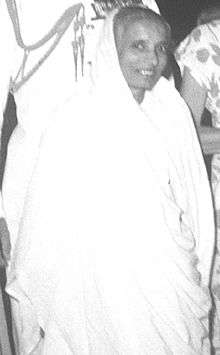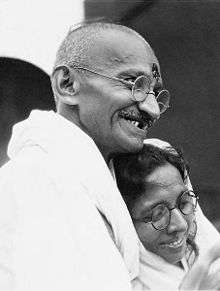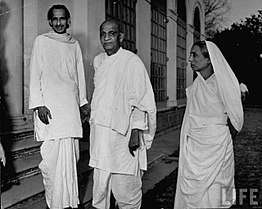Maniben Patel

Maniben Patel (3 April 1903, Karamsad-1990) was an Indian independence movement activist and a Member of the Indian parliament.[1] She was the daughter of freedom fighter and post-Independence Indian leader Sardar Vallabhbhai Patel. Educated in Mumbai, Maniben adopted the teachings of Mahatma Gandhi in 1918, and started working regularly at his ashram in Ahmedabad.
Early Life
Maniben was born on 3 April 1903 at Karamasad, Guajrat, India. She lost her mother when she was 6 years of age. She was brought up by her uncle Vitthalbhai Patel. She completed her early education at Queen Mary High School in Mumbai which was then known as Bombay. In 1920 She Migrated to Ahmedabad and joined Gujarat Vidhyapith started by Mahatma Gandhi. After completing her graduation in 1925, Maniben went on to assist her father. [2]
Borsad Movement
In 1923-24 British Government had levied heavy taxes and for recovery of the same they started confiscating their cattle, land, properties of the common people. to protest against his oppression, Maniben Motivated women to come out and join campaign led by Gandhiji and Sardar Patel and support No-tax movement. [2]
Bardoli Satyagrah
Exorbitant tax was levied by Britishers on the peasants of Bardoli in 1928 and were going similar harassament as that of Borsad. Mahatma Gandhi directed Sradar Vallabhbhai Patel to take leadership of the Satyagrah. Initially women were reluctant to join the movement, Maniben along with Mithuben Petit and Bhaktiba Desai motivated women, who ultimately outnumbered men in the movement. As a part of protest, they stayed in huts eracted on lands confiscated by the government. [2]
Rajkot Satyagrah
During 1938, Against the unjust rule of Diwan of Rajkot State a Satyagrah was planned. Kasturba Gandhi was keen to join the Satyagrah despite her poor health. Maniben Accompanied her. Later on the government passed an order to separate both the ladies. Maniben went on fast against the order and authorities allowed her to be with Kasturba Gandhi.[2]
Non-cooperation movement

She participated in the Non-Cooperation Movement as well as the Salt Satyagraha and was imprisoned for long periods of time. In the 1930s she became her father's aide, also caring for his personal needs. However, because Manibehn Patel was committed to the liberation of India, and thus the Quit India movement, she was again imprisoned from 1942 to 1945 in Yerwada Central Jail. Manibehn Patel served her father closely until his death in 1950. After moving to Mumbai, she worked for the rest of her life with numerous charitable organizations and for the Sardar Patel Memorial Trust. She went on to author an account of the freedom struggle as a book on her father's life in the years following Indian Independence.
Principles
Maniben always ensured that her and her fathers cloths are weaved from khadi threds which were spun by her. She always insisted on travelling in third class. [2]
Vice president
Maniben Vallabhai Patel was once Vice-President of the Gujarat Provincial Congress Committee. Later, she was elected as a member of Indian National congress led by Nehru in first lok sabha(1952–57) from South Kaira constituency,[3] in the second Lok Sabha (1957–62) from Anand.[4] She was also Secretary (1953–56) and Vice President (1957–64) of Gujarat state Congress. She was elected to Rajya Sabha in 1964 and continued till 1970. Information is lacking over whether it was as a Congress Party member, a Swatantra Party member or an NCO (Congress-O) member; both Swatantra Party and NCO (Prime Minister Morarji Desai's Congress group) were powerful in Gujarat during the years 1967-1971. She left Indira led Congress(I) to join Congress(O), opposed emergency and was elected to Lok Sabha from Mehsana on Janata party ticket in 1977.[5]

She was connected with several educational institutions including the Gujarat Vidyapith, Vallabh Vidyanagar, Bardoli Swaraj Ashram and Navajivan Trust prior to her death in 1990.
In 2011, the Sardar Vallabhbhai Patel Memorial Trust undertook a project to publish her Gujarati diary, in collaboration with Navajivan Publications.[6][7]
Works
- Inside Story of Sardar Patel: The Diary of Maniben Patel, 1936-50, by Manibahen Patel. Ed. Prabha Chopra. Vision Books, 2001. ISBN 81-7094-424-4.
References
- ↑ Joginder Kumar Chopra (1993). Women in the Indian parliament: a critical study of their role. Mittal Publications. p. 174. ISBN 978-81-7099-513-5.
- 1 2 3 4 5 Sushila Nayar, Kamla Mankekar (Editors) (2003). Women Pioneers In India's Renaissance. National Book Trust, India. p. 469. ISBN 81-237-3766 1.
- ↑ "Archived copy" (PDF). Archived from the original (PDF) on 4 April 2014. Retrieved 2014-06-02.
- ↑ http://eci.nic.in/eci_main/StatisticalReports/LS_1957/Vol_I_57_LS.pdf
- ↑ "Lok Sabha Website Members Biodata". Retrieved 2015-08-02.
- ↑ Vashi, Ashish (8 June 2011). "Knowing Sardar Patel through his daughter's diary". The Times of India. Ahmedabad. Retrieved 2013-06-02.
- ↑ Datta, V. N. (30 September 2001). "Patel's Legacy". The Tribune. Retrieved 2013-06-02.
External links
| Wikimedia Commons has media related to Maniben Patel. |